FIRE - Two Common Ways to Strike Flint and Steel for Fire Lighting
The use of ‘Flint & Steel’ is a very traditional way of making fire that stretches back in history to where man first started to use steel. It would have been quickly understood that steel gives off sparks when struck by something that is harder that it, such as natural flint, since the use of Iron Pyrite for creating sparks would have by that time been around for many thousands, if not hundreds of thousands of years. The discovery that steel could create larger and hotter sparks than the more traditional Iron Pyrite, would have been as revolutionary to them as the discovery of the relatively modern ferrocerium sparking flint rods was to our recent forebears.
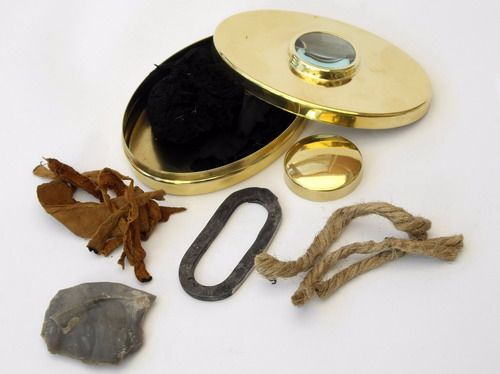
Traditional Brass Hudson Bay Tinder Box with Hand Forged Fire Steel (85-2010-BR)
Since the sparks created by ‘Flint & Steel’ from say a Hudson Bay Tinderbox, are large enough and hot enough to create an ember in so many more kind of tinder than would have been used when Iron Pyrite was in common use, ‘Flint & Steel’ would certainly, have very quickly superseded Iron Pyrite as the preferred method of fire lighting.
Using traditional ‘Flint & Steel’ is really quite simple to do, at least in principle that is. The natural, commonly held, belief is that all you need to do to create sparks, is to bang the flint and steel together. There is, however, a little more to it than that, a little refinement is required if sparks are going to be efficiently utilised to produce an ember and thence a fire. There are two distinct methodologies when it comes to creating sparks with traditional ‘Flint & Steel’, and these are The Flint on Steel Strike and The Steel on Flint Strike. These two distinct strikes then become, The Tinderbox Strike, The Tinder Bundle Strike and The Two Finger Strike, so let’s take a look at them:
Flint on Steel - The Tinderbox Strike
The Tinderbox Strike is probably the technique that is the most commonly viewed as the way our forebears would have used ‘Flint & Steel’ to create an ember. Personally, I do not see The Tinderbox Strike as being the most efficient way to create sparks, unless the tinder that is being used is in a powdered, or difficult to handle form. Powdered tinder could easily have been made by scraping the charcoal from unburned pieces of firewood and then stored in a box i.e. a Tinderbox!
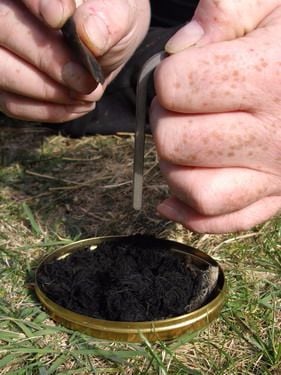
Photo 1
The practical application of this technique is to directly strike the sparks into the open tinderbox and onto the mass of charcoal, char cloth or some kind of natural tinder such as Amadou or Chaga. Throwing the sparks downwards into the tinderbox, an ember can easily be created in this way, since the tinder in the tin covers a large area and can therefore more readily catch any stray sparks (Photo 1).
To do this technique you will need to quickly and decisively strike a sharp edge of flint downwards towards the steel at about a 45° angle, as if you were trying to shave off a small piece of steel. The steel should be held a couple of inches above the tinderbox and tinder, so that all sparks are directed downwards and into the tinderbox.
Once a spark has been caught by some of the tinder, you can carefully encourage the embryonic ember to grow a little before you tease it from the main mass of tinder and place it in a previously prepared tinder bundle nest. It should be pointed out that this method may well produce several embers at the same time, since many sparks are generated upon each strike. Each spark being produced has the potential to create its own ember. If this happens, you can use the Steel, or flint, to extinguish the unwanted glowing embers, by pressing on them to eliminate the air and rapidly remove the heat, via conduction.
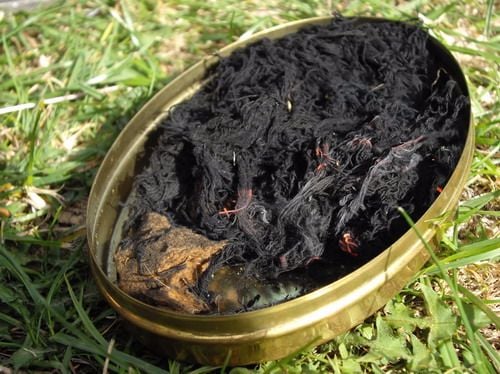
Photo 2
Photo 2 shows several areas that have caught a spark. If left unattended, for just a few seconds, the whole of the tinder would become a massive ember, which would be a waste of resources and be very difficult to extinguish without replacing the lid to eliminate the air. If the tin lid is not airtight the tinder will continue to burn until it is gone, you may be able to judge that this is the case because the tin will become, and stay, very hot.
The Tinder Bundle Strike
The second way is to tease out a small pinch of tinder and place it in a tinder bundle nest that has previously being prepared. Place the tinder bundle nest on the ground and strike the Flint against the Steel as described in ‘The Tinderbox Strike’, above. Once the tinder has caught a spark and begins to glow, you can blow the tinder bundle nest into a flame and then place it in your fire pit.
The Two Finger Strike
The third way, which is also my preferred way of using traditional ‘Flint & Steel’, assuming that I have a type of tinder that can be easily held, and then pinched between fingers, without crushing or crumbling, such as Amadou or Chaga. 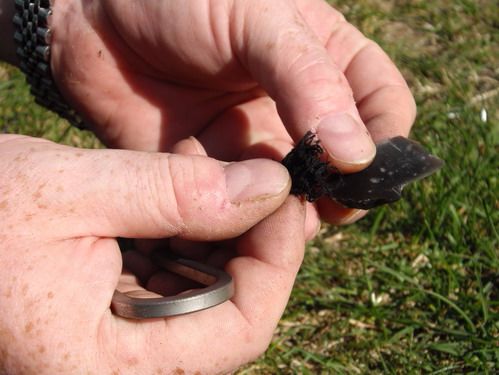
Photo 3
Placing the tinder about 1 to 2mm from the edge of the natural flint. The idea is to tease out a two finger pinch of the tinder, say Char Cloth, Amadou or Chaga, and place it onto a piece of natural flint, about 2 to 3mm from one of the flints sharp edges (Photo 3).
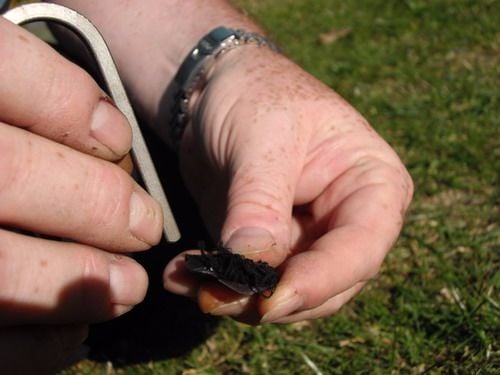
Photo 4
It is very important that you make sure that the edge of the flint is as sharp as possible (Photo 4).
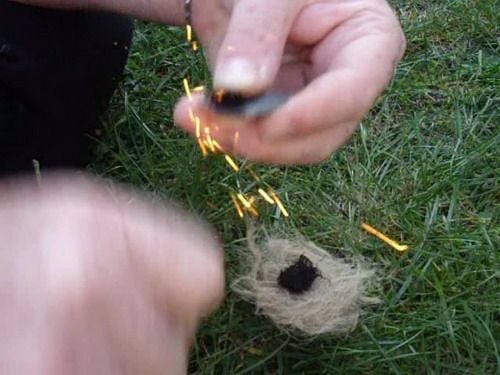
Photo 5
Whilst holding the tinder firmly against the flint, but without overtly crushing it, with your thumb and forefinger, you should sharply strike the Steel down against the flint edge as if trying to shave off the thinnest sliver of steel (Photo 5).
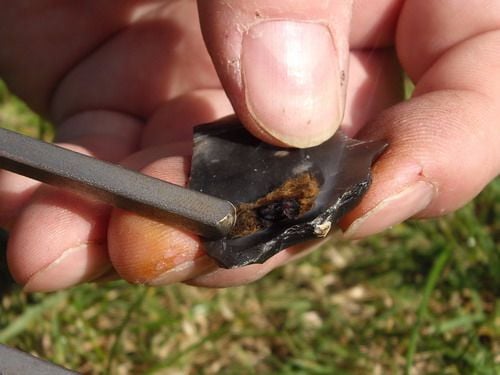
Photo 6
The sparks that are produced should be directed towards the edge of the char cloth (Photo 6).
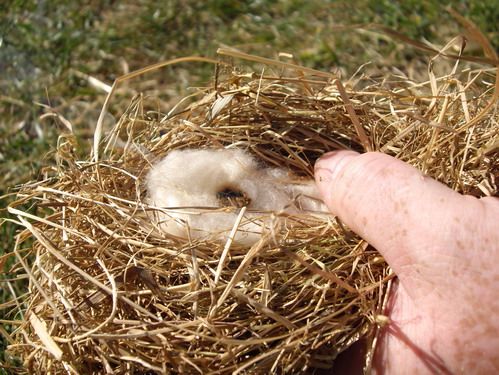
Photo 7
Place the ember in the previously prepared tinder bundle nest (Photo 7)) and gently blow into a flame (Photos 8 and 9).
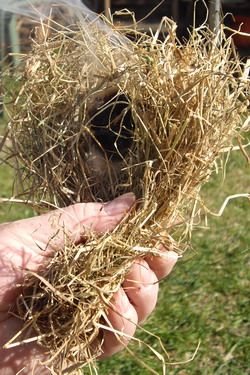
Photo 8
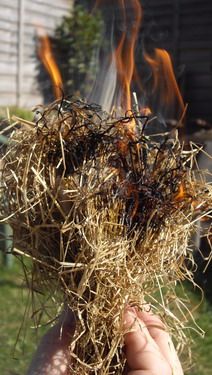
Photo 9
